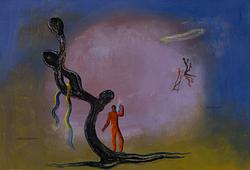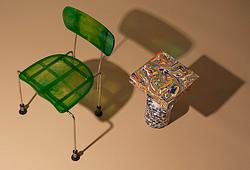Anders Zorn
"Timret går" (Timber)
Signed Zorn and dated 1916. Oil on canvas 120 x 98 cm.
Import VAT
Import VAT (12%) will be charged on the hammer price on this lot. For further details please contact customer service +46 8-614 08 00.
Provenance
The collection of Max Lester, Copenhagen (before 1924, possibly acquired in connection with the exhibition at Charlottenborg, Copenhagen, 1916); his sale, Copenhagen, April 1924; the collection of managing director Hansén, Malmö, Sweden (acquired at the above sale); the collection of engineer Henry Evensen, Helsingborg, Sweden (before 1934); his sale, Concert Hall, Helsingborg, Sweden, September 1934; the collection of managing director Sven Schwartz, Djursholm, Sweden (by 1942 or 1943); Mrs. Schwartz, Stockholm (probably by descent from the above mentioned); Nordén Auktioner, Stockholm, “Sale N:o 8 – Scandinavian Art and Antiques”, 11 May 1993, lot 110; J.E. Safra Collection (acquired at the above sale).
Exhibitions
Charlottenborg Art Gallery, Copenhagen, 1916, no. 813.
Literature
"Konst i svenska hem", second edition, vol. 12, listed and illustrated p. 626 under collection 1081:”Direktör Sven Schwartz, Strandvägen 19, Djursholm”; Gerda Boëthius, “ZORN. Tecknaren, Målaren, Etsaren, Skulptören”, 1949, catalogued under year 1916, p. 554.
More information
When he painted "Timret går (Timber)" in 1916 Anders Zorn was at the absolute height of his fame and fortune. His paintings were sold by prominent galleries and swept up by important collectors on both sides of the Atlantic. He lived in a spectacular manor house in his home town of Mora whilst also keeping a grand studio apartment in the very heart of Stockholm. Showered in medals, praise and, not least, money (when Zorn died four years later his estate was valued at what today amounts to more than $8 million) there seemed to remain little left for him to do in order to prove himself as an artist.
This however, as by divine inspiration, is exactly what he does when, in his twilight years, he reaches for the brush and paint tubes in the open air just outside of his hometown of Mora. The setting of the scene was Zorn’s rough and rustic fisherman cabin and outdoors studio called Gopsmorstugan (The Gopsmor Cabin).
Here he returns to where, according to leading art experts, “it all began” in the summer of 1887. Zorn, himself, remembers in his autobiographical notes:
"How it came about, that just this summer [1887] I tried what is still my favourite theme, the naked body of a woman in the open air, I do not remember. […] The Academy provided me with a cast off model (too fat), a working woman from the candy factory, we were taken out to the islands by an old man from Dalarö, where I painted some bathing women after this exuberant girl. A combination of grey cliffs, pine trees, nudity and water. When I look at this piece now, I get the impression that the latter element inspired me more than the others. Later on it has had to yield in favour of the reflection of light on the naked body".
Anders Zorn created a whole new and totally independent genre of painting parallel to the traditional style. He would nurse and develop the theme of “Naked in the open air” for the rest of his life, making it his absolute forte. "Timber" is a remarkable example of the above and exemplifies his mastery of the genre (that produced a majority of his most beloved works) throughout his entire career.
On one of his largest canvases Zorn manages to create a sensual and intimately cropped close-up (based on his extensive knowledge of photography as well as love of Japanese woodblock prints) of a beautiful model whose averted face is throwing a downward glance into the river. The unclad model might, by some objectors, be said to be expected in a painting by Zorn, but here she mostly functions as a focal point (heightened by the dazzling red of her hair ribbon which was part of the traditional Mora folk garb) bringing attention to the overall important theme of the composition: the surface of the swirling water of the mighty river in the background. Furthermore she also facilitates the artist's desire to demonstrate his abilities to render the effects of natural light as it reflects on different surfaces and textures: the soft naked human flesh, the hard and rough stone she is sitting on, the grass, foliage and branches in the foreground, the timber in the river and, above all, the ever changing surface of the water itself.
Zorn based some of his most perfectly balanced compositions on what has been described as a “broken diagonal” and possibly some traces of this can be seen in his arrangement of the timber in the background. Overall, however, it is a celebration of the beauty of natural light rendered in a limited palette. Zorn was noted for executing impressive paintings using a sober colour scale limited to white, ochre, vermilion and ivory black, and when observing Timber one realizes that the artist probably executed the canvas with just a handful of paints on his palette. Technical aspects, for all they are worth, can only say so much, however. Is it really necessary to seek out and apply arguments to support a piece of art that stands on its own through its immediate sensualism and beauty?
The answer would probably be no, if the question was put to any of the many important collectors who have owned and treasured this piece since its creation 100 years ago. As shown by its provenance "Timber" has been passed from one impressive collection to another, through a variety of auction sales, over the years, often being hailed as the most important piece in each sale and also fetching the highest bid of each sale. When included in the sale of the Max Lester Collection in Copenhagen in 1924, for example, media reported that “the finest piece of the entire sale” was “the radiant woman against the glittering river” by Zorn which was sold “for a minor fortune”.
Please note that on this lot there is a security interest with a Third Party.
Artist
Anders Zorn, born in Mora in 1860, showed artistic talent from a young age. In 1875, he traveled to Stockholm and became a student at the then Slöjdskolan (now Tekniska högskolan) in Stockholm, and shortly after, he joined the Royal Academy of Fine Arts. Initially, Zorn had aspirations of becoming a sculptor, but soon watercolor painting took over, becoming his primary medium until 1887. At the student exhibition in 1880, Zorn had his breakthrough with the watercolor painting "I sorg." The following year, he gained international acclaim as a portrait painter. His watercolor painting reached its pinnacle during this period, and his most famous work from this time is "Vårt dagliga bröd” from 1886. Shortly thereafter, Zorn transitioned to oil painting, which was met with immediate success. Zorn's reputation mainly rested on his portrait art, and he portrayed many notable figures, including presidents. For instance, he created an etching of Theodore Roosevelt. His etchings significantly contributed to his success. In the late 1880s, Zorn began working in the genre that would increasingly become his trademark: nude figures in outdoor settings. He had long been fascinated by the movement of water and the reflections of light on its surface. Now, he added the complexity of placing a model near or in the water, aiming to depict a synthesis between nature and humanity. In 1896, Zorn and his wife moved back to Sweden and settled in Zorngården in Mora. This move sparked a renewed interest in his homeland, which would be reflected in his future paintings. Among the artist's scenes from the Mora region, portraying its local customs and ancient traditions, "Midsommardansen" holds the highest value according to Zorn himself. Today, the painting can be found at the National Museum.
Read more






































